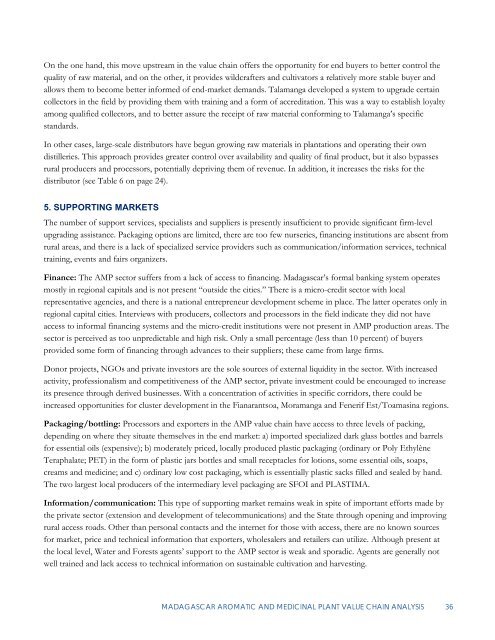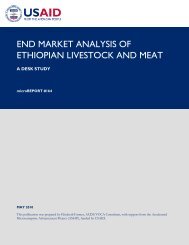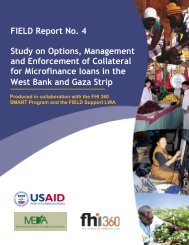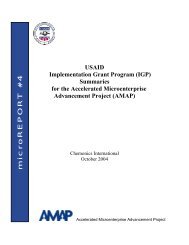Madagascar Aromatic and Medicinal Plants Value - Microlinks
Madagascar Aromatic and Medicinal Plants Value - Microlinks
Madagascar Aromatic and Medicinal Plants Value - Microlinks
Create successful ePaper yourself
Turn your PDF publications into a flip-book with our unique Google optimized e-Paper software.
On the one h<strong>and</strong>, this move upstream in the value chain offers the opportunity for end buyers to better control the<br />
quality of raw material, <strong>and</strong> on the other, it provides wildcrafters <strong>and</strong> cultivators a relatively more stable buyer <strong>and</strong><br />
allows them to become better informed of end-market dem<strong>and</strong>s. Talamanga developed a system to upgrade certain<br />
collectors in the field by providing them with training <strong>and</strong> a form of accreditation. This was a way to establish loyalty<br />
among qualified collectors, <strong>and</strong> to better assure the receipt of raw material conforming to Talamanga’s specific<br />
st<strong>and</strong>ards.<br />
In other cases, large-scale distributors have begun growing raw materials in plantations <strong>and</strong> operating their own<br />
distilleries. This approach provides greater control over availability <strong>and</strong> quality of final product, but it also bypasses<br />
rural producers <strong>and</strong> processors, potentially depriving them of revenue. In addition, it increases the risks for the<br />
distributor (see Table 6 on page 24).<br />
5. SUPPORTING MARKETS<br />
The number of support services, specialists <strong>and</strong> suppliers is presently insufficient to provide significant firm-level<br />
upgrading assistance. Packaging options are limited, there are too few nurseries, financing institutions are absent from<br />
rural areas, <strong>and</strong> there is a lack of specialized service providers such as communication/information services, technical<br />
training, events <strong>and</strong> fairs organizers.<br />
Finance: The AMP sector suffers from a lack of access to financing. <strong>Madagascar</strong>’s formal banking system operates<br />
mostly in regional capitals <strong>and</strong> is not present “outside the cities.” There is a micro-credit sector with local<br />
representative agencies, <strong>and</strong> there is a national entrepreneur development scheme in place. The latter operates only in<br />
regional capital cities. Interviews with producers, collectors <strong>and</strong> processors in the field indicate they did not have<br />
access to informal financing systems <strong>and</strong> the micro-credit institutions were not present in AMP production areas. The<br />
sector is perceived as too unpredictable <strong>and</strong> high risk. Only a small percentage (less than 10 percent) of buyers<br />
provided some form of financing through advances to their suppliers; these came from large firms.<br />
Donor projects, NGOs <strong>and</strong> private investors are the sole sources of external liquidity in the sector. With increased<br />
activity, professionalism <strong>and</strong> competitiveness of the AMP sector, private investment could be encouraged to increase<br />
its presence through derived businesses. With a concentration of activities in specific corridors, there could be<br />
increased opportunities for cluster development in the Fianarantsoa, Moramanga <strong>and</strong> Fenerif Est/Toamasina regions.<br />
Packaging/bottling: Processors <strong>and</strong> exporters in the AMP value chain have access to three levels of packing,<br />
depending on where they situate themselves in the end market: a) imported specialized dark glass bottles <strong>and</strong> barrels<br />
for essential oils (expensive); b) moderately priced, locally produced plastic packaging (ordinary or Poly Ethylène<br />
Teraphalate; PET) in the form of plastic jars bottles <strong>and</strong> small receptacles for lotions, some essential oils, soaps,<br />
creams <strong>and</strong> medicine; <strong>and</strong> c) ordinary low cost packaging, which is essentially plastic sacks filled <strong>and</strong> sealed by h<strong>and</strong>.<br />
The two largest local producers of the intermediary level packaging are SFOI <strong>and</strong> PLASTIMA.<br />
Information/communication: This type of supporting market remains weak in spite of important efforts made by<br />
the private sector (extension <strong>and</strong> development of telecommunications) <strong>and</strong> the State through opening <strong>and</strong> improving<br />
rural access roads. Other than personal contacts <strong>and</strong> the internet for those with access, there are no known sources<br />
for market, price <strong>and</strong> technical information that exporters, wholesalers <strong>and</strong> retailers can utilize. Although present at<br />
the local level, Water <strong>and</strong> Forests agents’ support to the AMP sector is weak <strong>and</strong> sporadic. Agents are generally not<br />
well trained <strong>and</strong> lack access to technical information on sustainable cultivation <strong>and</strong> harvesting.<br />
MADAGASCAR AROMATIC AND MEDICINAL PLANT VALUE CHAIN ANALYSIS 36





